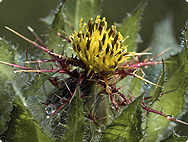
This member of the daisy family has a long history of medicinal use, having been mentioned in both the Bible and Shakespeare’s writing as a beneficial herb. The thistle gets its name from the French Emperor Charlemange (742 – 814 AC). His army was being threatened with an epidemic of the bubonic plague when he told his men of a visit by an angel. This angel informed him that if he shot an arrow into the air, the arrow would land upon a plant that would cure the disease. His arrow found the Blessed Thistle, and although it was not the end of the plague, it has proved to be worthy of its name.
Historically, teas made from Blessed Thistle have been said to purify the blood and increase circulation, being used to treat liver ailments, break up blood clots and relieve jaundice. Teas made from this herb are also used to reduce fevers associated with respiratory ailments, increase appetite, and treat febrile conditions. It was relied upon heavily by nursing mothers as it contains cnicin, which aids in the production of breast milk. High calcium and iron content also helps to produce a richer, more superior milk. Extracts have been used for their considerable anti-bacteria and anti-yeast qualities to treat various skin conditions such as Candida albicans.
In modern research, cell cultures have shown cytotoxicity against cancer cells using Blessed Thistle extract. Studies have also shown anti-tumor activity in sarcomas. Compounds in this herb are reported to have anti-HIV properties.



